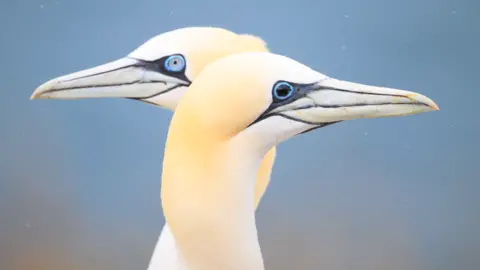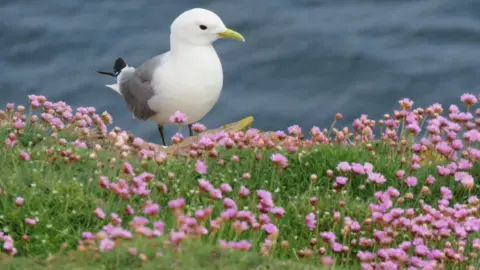Avian flu cases confirmed on Scottish nature reserves
 Ron Macdonald
Ron MacdonaldAvian flu outbreaks have been confirmed at nature reserves across Scotland.
The National Trust for Scotland (NTS) said two kittiwakes had tested positive at its site at St Abb's Head in the Scottish Borders.
Scotland's nature agency also said bird flu had been confirmed at its Forvie reserve in Aberdeenshire and on the Isle of May in the Firth of Forth.
NatureScot said its avian flu task force was now on "high alert" due to dead seabird numbers in coastal areas.
It comes after more than 1,000 dead birds were removed from Aberdeenshire beaches in recent days.
At Stonehaven more than 520 birds were recovered over the course of three days while a further 120 were collected at Cruden Bay.
And on Wednesday more than 250 dead birds were removed from Inverbervie as well as 150 from Balmedie.
NTS said positive tests on two kittiwakes at St Abb's Head were not unexpected due to the number of dead birds, but stressed many thousands of others were still doing well.
NatureScot said avian flu had been confirmed in sandwich terns, common terns, kittiwakes, herring gulls, black-headed gulls and guillemots so far this year.
At Forvie more than 200 sandwich terns have died with test results awaited on common and arctic terns. Kittiwakes have also tested positive on the Isle of May.
NatureScot said the overall picture across the country was "not yet clear" with tests on some birds in other parts of the having come back negative.
Wildlife manager Alastair MacGugan said: "Unfortunately after a quieter period we are beginning to see an increase in the number of dead birds being reported through our surveillance network, particularly on the east coast.
"While we are thankfully not seeing the large numbers of dead birds around breeding sites that we did last year, this development is really concerning.
"We're working hard with all partners in Scotland's avian flu task force to understand what is happening and take action to make our wild bird populations more resilient."
 Lorne Gill/Nature Scot
Lorne Gill/Nature ScotDr Liz Huphreys, British Trust for Ornithology (BTO) principal seabird ecologist, said it was clear that seabirds were still being badly affected by avian flu despite the situation initially seeming "less catastrophic" than last year.
Paul Walton, of the RSPB, said seabird numbers had already dropped by nearly 50% between 1986 and 2019 prior to the "devastating impacts" of bird flu last year.
He said it was time for conservation efforts to be "prioritised and resourced" to help protect these "incredible creatures".
Members of the public should avoid touching sick or dead birds and report them via the UK government's web page.

'It could be the tipping point for kittiwakes'

The head ranger at St Abb's Head, Ciaran Hatsell, said they were trying to stay positive.
"We have lost a lot of kittiwakes this year to avian flu," he said.
"It was mainly adults that we were losing but now we are starting to see it in chicks as well. It has hit a bit later this year than it did last year - we were hopeful that we had got away with it."
He said it was the last thing they needed after seeing the population decline by more than 70% in the last 30 years.
"This virus could really be the tipping point for the population reaching an unviable level," he said.
However, he added that there were some signs of hope.
"We have got gannets that are showing black eyes," he said.
"Recent studies carried out by the Scottish Seabird Centre and the RSPB have shown that the black eyes mean that it has had exposure to the virus and survived which is brilliant news.
"It is one of the first real signs of hope."

 NTS
NTSThe RSPB's Troup Head Nature Reserve, on the Aberdeenshire coast, is Scotland's largest mainland gannet colony, as well as home to thousands of kittiwakes and guillemots.
Last year the site was ravaged by avian flu, losing about 3,000 gannets. About 5,000 chicks also died - more than 90% of the total.
Richard Humpidge, the site manager, described the current avian flu situation in Scotland as "pretty grim".
"Guillemots and kittiwakes have halved in number over the last two decades and this is just knocking the numbers further down," he said.
"Like the gannets at Troup Head last year, it's not going to be until next year when the birds come back that we're going to have an indication as to how badly they have been affected.
"We know it's going to be bad, we just don't know how bad."
He said birds had already been vulnerable due to food shortages.
"If we add another stress factor into that, such as avian flu, it's going to have a devastating effect."
Annual hunt off
Meanwhile, an annual hunt of young seabirds in the Western Isles will not go ahead again this year due to concerns about the virus.
Usually, every year, about 2,000 gannet chicks are taken from the island of Sula Sgeir, 40 miles (64km) north of Ness on Lewis, to be eaten as a delicacy.
The two-week hunt has been a tradition since the 15th Century, and modern harvests are permitted under licence.
It did not take place last year because of concerns about bird flu, and the team of hunters, known as the Men of Ness, have decided not to go out this year.
Sula Sgeir is an uninhabited island which is home to between 9,000 and 10,000 pairs of gannets.
NatureScot said: "The last visit to Sula Sgeir, in 2022, did not show out-of-the-ordinary colony mortality.
"However, we are conscious that avian flu may have hit the colony later last summer, hence follow-up work this year to check the health of colony."
